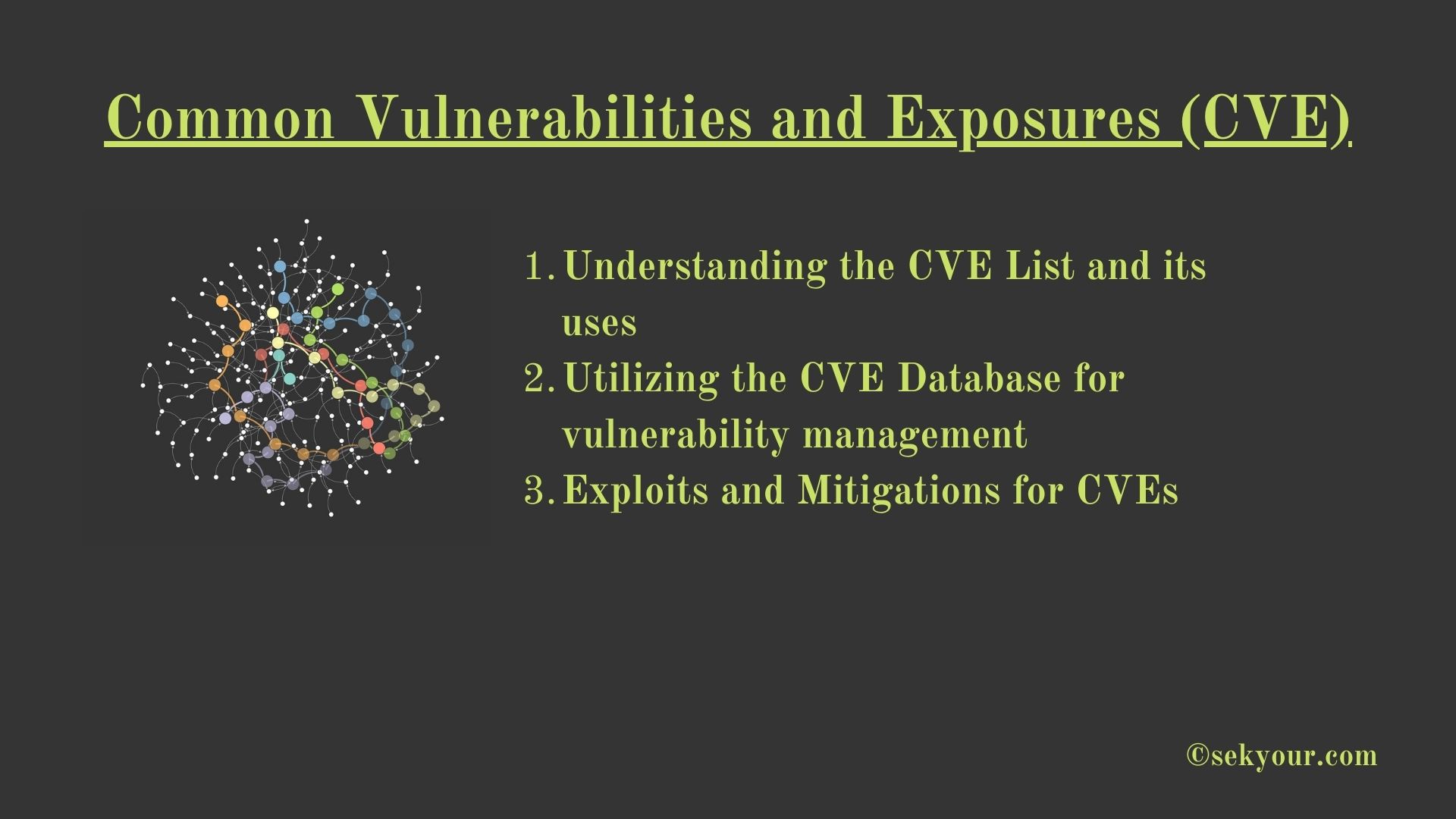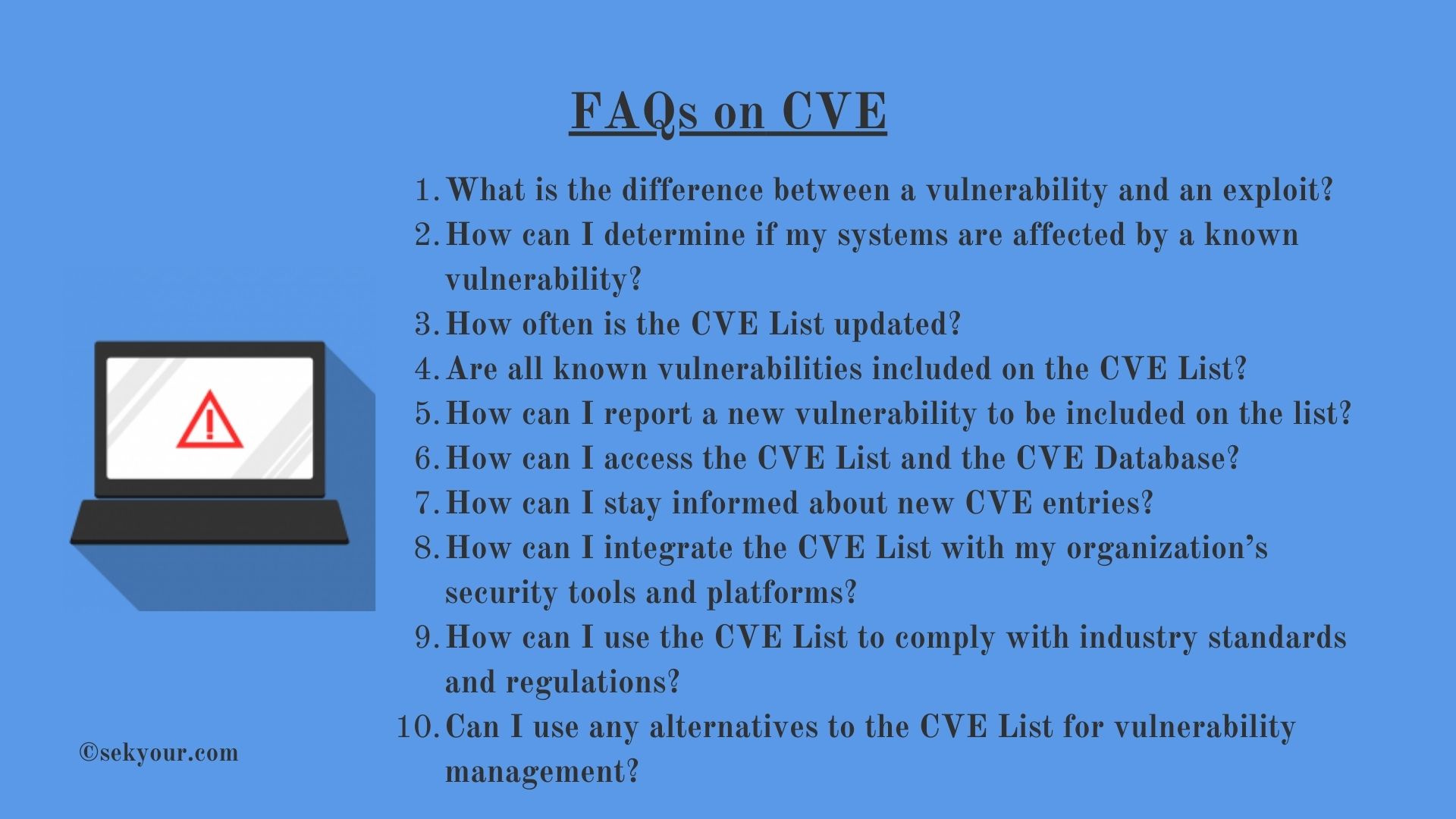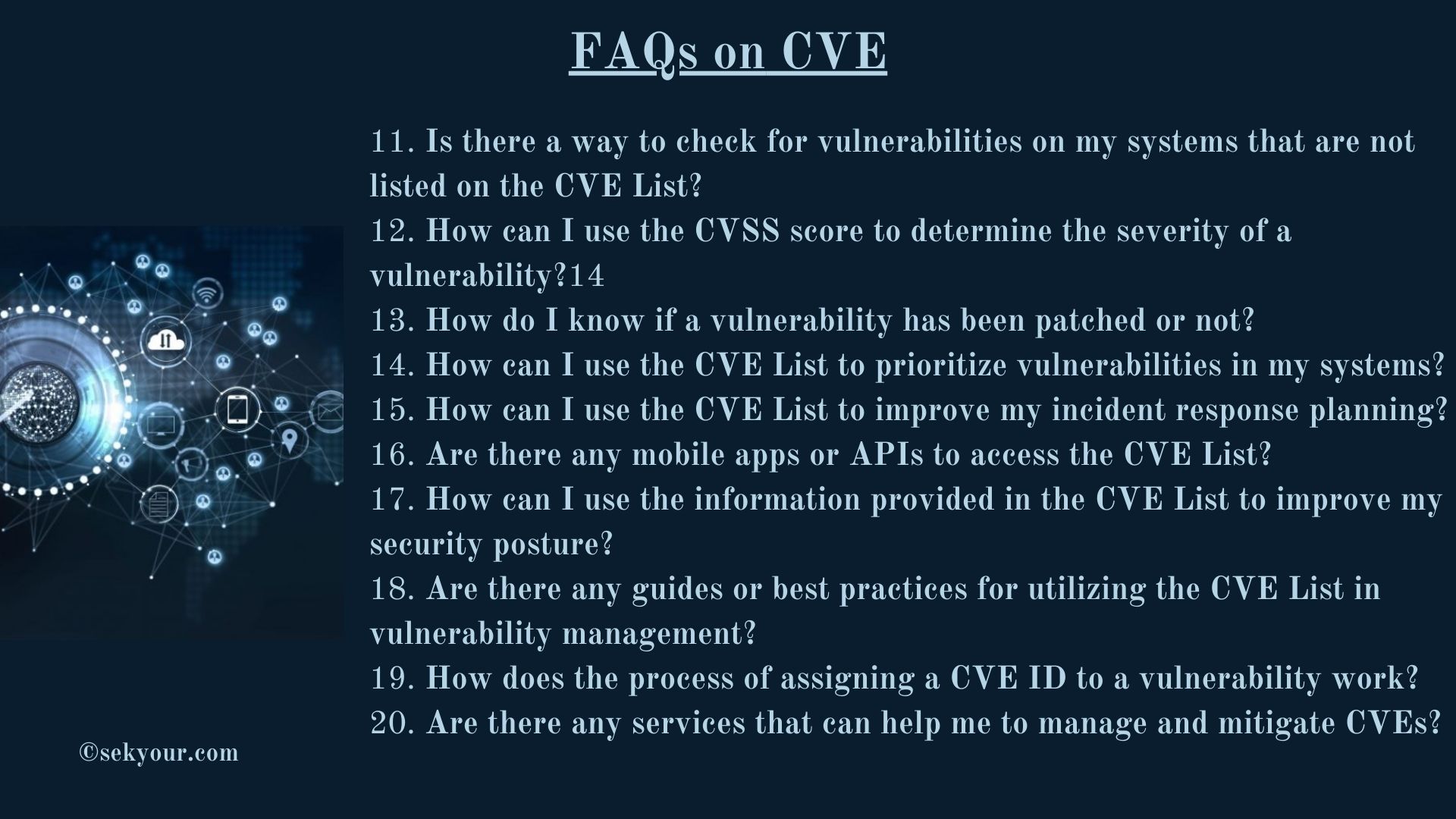1. Introduction to Common Vulnerabilities and Exposures (CVE) and its importance in cybersecurity
Common Vulnerabilities and Exposures (CVE) is a standardised naming scheme for security vulnerabilities and exposures. The project aims to provide a unique identifier for each vulnerability, allowing for easy identification and tracking. The CVE List, which is maintained by the National Cybersecurity and Communications Integration Center (NCCIC), is a comprehensive list of all known CVEs. The list is updated regularly and provides detailed information on each vulnerability, including a description and a CVSS score.
Organizations need to keep track of known vulnerabilities and the associated CVEs, as they can be exploited by cybercriminals. Real-world examples of high-profile incidents where CVEs played a significant role include the WannaCry ransomware attack and the Heartbleed vulnerability. These incidents have caused widespread damage to organizations and individuals, both in terms of financial loss and reputational damage.
According to the statistics, the number of reported CVEs is increasing yearly, and the industries most affected are IT and healthcare. Organizations must identify and manage CVEs to protect against cyberattacks. This can be achieved through continuous monitoring of the CVE List, implementing effective patch management processes, and utilising security tools that integrate with the CVE List.
Moreover, unpatched vulnerabilities can severely impact an organization’s reputation and financial loss. In some cases, a single unpatched vulnerability can be used by cybercriminals to launch a devastating attack. Therefore, it is essential for organizations to take a proactive approach to vulnerability management and to prioritize the patching of known vulnerabilities.

2. Understanding the CVE List and its uses
By accessing the CVE List, organizations can identify and prioritize vulnerabilities in their own systems. This is important as it allows organizations to focus on patching the most critical vulnerabilities first. Case studies of organizations successfully utilizing the CVE List in their vulnerability management programs can be found online, and they demonstrate the effectiveness of this approach.
When utilizing the CVE List in vulnerability management and mitigation, there are best practices that should be followed. These include continuously monitoring the list for new vulnerabilities, prioritizing vulnerabilities based on severity, and implementing effective patch management processes.
Organizations can also report new vulnerabilities to be included on the list. The process involves submitting a vulnerability report to the NCCIC, which will then assign a unique CVE ID to the vulnerability and add it to the list. The severity of a vulnerability is determined using the CVSS score, which is a numerical value that reflects the seriousness of the vulnerability.
It is important to note that not all known vulnerabilities are included on the list. Some vulnerabilities may not be known or reported to the NCCIC. However, the list is considered to be the most comprehensive and widely used list of known vulnerabilities.
3. Utilizing the CVE Database for vulnerability management
Utilizing the CVE Database is an important aspect of vulnerability management. The database, which is maintained by the National Cybersecurity and Communications Integration Center (NCCIC), can be searched for specific vulnerabilities by using keywords or by browsing through the list of known vulnerabilities. This allows organizations to identify the most relevant vulnerabilities to their systems.
When utilizing the database, there are best practices that should be followed. These include continuous monitoring for new vulnerabilities, prioritizing vulnerabilities based on severity, and implementing effective patch management processes. Additionally, it is important to integrate the CVE database with security tools and platforms to improve the efficiency and effectiveness of vulnerability management.
The CVE List is considered the most comprehensive and widely used list of known vulnerabilities. However, other vulnerability databases are available, such as the National Vulnerability Database (NVD) and the OpenVAS Vulnerability Database. Understanding how the CVE List relates to these other databases is essential to make informed decisions about vulnerability management.
Staying informed about new CVE entries is crucial for effective vulnerability management. Organizations can subscribe to email notifications or RSS feeds to receive updates on new entries as they are added to the list. Additionally, case studies of organizations that have successfully used the database to improve their vulnerability management programs can be found online. These case studies demonstrate the effectiveness of utilizing the database in vulnerability management and can provide valuable insights for organizations looking to improve their vulnerability management programs.
4. Exploits and Mitigations for CVEs
Exploits are malicious scripts or software used to exploit vulnerabilities to gain unauthorized access or control of a system. There are different types of exploits that can be used to exploit vulnerabilities, such as buffer overflow attacks, SQL injection attacks, and phishing attacks. Understanding the different types of exploits and how they are used to exploit vulnerabilities is essential for organizations to protect themselves against cyberattacks.
Mitigating and protecting against CVEs requires a multi-layered approach. This can include implementing security controls, such as firewalls and intrusion prevention systems, and best practices for vulnerability management, such as continuous monitoring, patch management, and incident response planning. Additionally, organizations should ensure compliance with industry standards and regulations, such as the Payment Card Industry Data Security Standard (PCI DSS), which requires organizations to protect against known vulnerabilities.
Organizations should implement best practices for vulnerability management to identify and patch vulnerabilities, such as continuous monitoring, prioritizing vulnerabilities based on their severity, and implementing effective patch management processes. Real-world examples of successful exploit mitigations can be found online and can provide valuable insights for organizations looking to improve their own vulnerability management programs.
Threat intelligence plays an important role in identifying and mitigating CVEs. This can include monitoring for new vulnerabilities, tracking known attack campaigns, and identifying indicators of compromise. By utilizing threat intelligence, organizations can improve their ability to detect and respond to cyberattacks. Additionally, organizations should ensure that the threat intelligence they are using is relevant and timely by subscribing to threat intelligence feeds and researching
5. Conclusion
In conclusion, the importance of continuous monitoring and management of Common Vulnerabilities and Exposures (CVEs) cannot be overstated. The CVE database and list, maintained by the National Cybersecurity and Communications Integration Center (NCCIC), is a valuable resource for organizations looking to identify and mitigate known vulnerabilities. By utilizing the database and list in vulnerability management, organizations can improve their ability to protect themselves against cyberattacks.
The benefits of utilizing the database and list in vulnerability management include the ability to identify and prioritize vulnerabilities, stay informed about new entries, and ensure compliance with industry standards and regulations. Additionally, organizations can access the list through APIs and mobile apps, which makes it more accessible and convenient. There are also similar lists, like the CVE, which can be used for reference.
Organizations must implement effective CVE management practices to protect themselves against cyberattacks. By following the best rules for vulnerability management, such as continuous monitoring, patch management, and incident response planning, organizations can improve their ability to detect and respond to cyberattacks.
For readers looking to learn more about CVEs and vulnerability management, a variety of additional resources are available. These include industry standards and regulations, such as the Payment Card Industry Data Security Standard (PCI DSS), as well as guides and best practices from organizations such as the National Cybersecurity Centre (NCSC) and the SANS Institute
6. FAQs on CVE

1. What is the difference between a vulnerability and an exploit?
A vulnerability is a weakness or gap in a system’s security that can be exploited by an attacker to gain unauthorized access or control. An exploit is a malicious script or software that takes advantage of a vulnerability to attack.
2. How can I determine if my systems are affected by a known vulnerability?
You can check the Common Vulnerabilities and Exposures (CVE) List, a comprehensive list of all known vulnerabilities, to find out if your systems are affected by a known vulnerability. You can also use vulnerability scanning tools to check your systems for known vulnerabilities.
3. How often is the CVE List updated?
The CVE List is updated regularly, and new entries are added as they are reported.
4. Are all known vulnerabilities included on the CVE List?
The CVE List is considered the most comprehensive and widely used list of known vulnerabilities, but it is not exhaustive. Some vulnerabilities may not be known or reported to the National Cybersecurity and Communications Integration Center (NCCIC), which maintains the list.
5. How can I report a new vulnerability to be included on the list?
To report a new vulnerability, you should submit a vulnerability report to the NCCIC. The report should include detailed information about the vulnerability, such as a description, affected systems, and proof-of-concept code. The NCCIC will then assign a unique Common Vulnerabilities and Exposures (CVE) ID to the vulnerability and add it to the list.
6. How can I access the CVE List and the CVE Database?
The Common Vulnerabilities and Exposures (CVE) List and the CVE Database can be accessed through the National Cybersecurity and Communications Integration Center (NCCIC) website. The website provides search functionality for the list and a detailed view of each vulnerability.
7. How can I stay informed about new CVE entries?
Organizations can subscribe to email notifications, or RSS feeds to receive updates on new entries as they are added to the list. Organizations can also use threat intelligence feeds and platforms to stay updated on new vulnerabilities and CVEs.
8. How can I integrate the CVE List with my organization’s security tools and platforms?
Many security tools and platforms have the capability to integrate with the CVE List, which allows organizations to check for known vulnerabilities and take appropriate actions, such as patching. Organizations can check with the vendor of their security tools and platforms to see if they provide integration with the CVE List.
9. How can I use the CVE List to comply with industry standards and regulations?
Using the CVE List can help organizations to comply with industry standards and regulations, such as the Payment Card Industry Data Security Standard (PCI DSS), by identifying known vulnerabilities and taking appropriate actions to mitigate them.
10. Can I use any alternatives to the CVE List for vulnerability management?
There are other vulnerability databases available, such as the National Vulnerability Database (NVD)

11. Is there a way to check for vulnerabilities on my systems that are not listed on the CVE List?
Yes, there are ways to check for vulnerabilities on systems not listed on the CVE List. Organizations can use vulnerability scanning tools that scan for known and unknown vulnerabilities or penetration testing to identify vulnerabilities that may not be known or listed on the CVE List.
12. How can I use the CVSS score to determine the severity of a vulnerability?
CVSS (Common Vulnerability Scoring System) is a numerical value that reflects the severity of a vulnerability. The score is calculated based on factors such as the complexity of the attack, the potential impact of the vulnerability, and the availability of mitigations. Organisations can use the CVSS score to determine the severity of a vulnerability and prioritize their patching and mitigation efforts accordingly.
13. How do I know if a vulnerability has been patched or not?
Organizations can check the vendor’s website or contact the vendor directly to confirm if a patch is available for a specific vulnerability. Additionally, organizations can use security tools that integrate with the CVE List to check if a patch has been applied to their systems.
14. How can I use the CVE List to prioritize vulnerabilities in my systems?
Organizations can use the CVSS score and the information provided in the CVE List to prioritize vulnerabilities in their systems. By prioritizing vulnerabilities based on their severity, organizations can focus on patching the most critical vulnerabilities first.
15. How can I use the CVE List to improve my incident response planning?
Organizations can use the CVE List to identify known vulnerabilities that could be exploited in an attack, and include them in their incident response planning. This can help organizations to quickly identify and respond to potential attacks and minimize the impact of a successful breach.
16. Are there any mobile apps or APIs to access the CVE List?
Yes, mobile apps and APIs allow organizations to access the CVE List from their mobile devices or automate their vulnerability management processes. These apps and APIs can be found on the National Cybersecurity and Communications Integration Center (NCCIC) website or from third-party providers.
17. How can I use the information provided in the CVE List to improve my security posture?
Using the information provided in the CVE List, organisations can identify and prioritize vulnerabilities in their systems, implement effective patch management processes, and stay informed about new vulnerabilities. This can help organizations to improve their overall security posture and reduce the risk of a successful cyberattack.
18. Are there any guides or best practices for utilizing the CVE List in vulnerability management?
There are guides and best practices available from organizations such as the National Cybersecurity Centre (NCSC) and the SANS Institute that provide recommendations for utilizing the CVE List in vulnerability management.
19. How does the process of assigning a CVE ID to a vulnerability work?
When a new vulnerability is reported, the National Cybersecurity and Communications Integration Center (NCCIC) assigns a unique Common Vulnerabilities and Exposures (CVE) ID to the vulnerability and adds it to the list. The ID is a unique identifier that allows organizations to quickly reference the vulnerability in their security tools and processes.
20. Are there any services that can help me to manage and mitigate CVEs?
Yes, there are a variety of services that can help organizations to manage and mitigate CVEs. These services include vulnerability scanning, penetration testing, incident response, and threat intelligence. Organizations can hire security consultants or managed security service providers (MSSPs) to help them manage and mitigate CVEs.